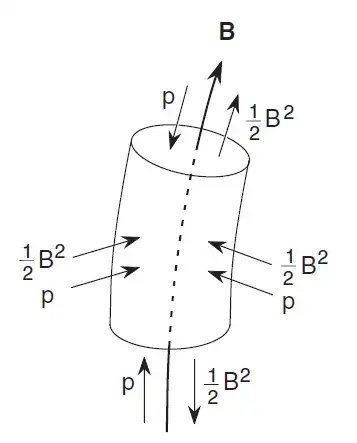In general a term $(\mathbf{v} \cdot \mathbf{\nabla}) \mathbf{A}$ is the directional derivative of $\mathbf{A}$ in the direction of $\mathbf{v}$. It tells you how $\mathbf{A}$ is changing when you move along $\mathbf{v}$.
Here, we have $(\mathbf{B} \cdot \mathbf{\nabla}) \mathbf{B}$, which is telling how much $\mathbf{B}$ changes as we move in the direction of $\mathbf{B}$. This term will be zero if $\mathbf{B}$ is constant in magnitude and direction as you move along a stream line of $\mathbf{B}$.
What if $\mathbf{B}$ is not constant as you move along a flow line? Let's look at the example where $\mathbf{B}$ points in the $\hat{x}$ direction, but gets bigger as you move from the origin. So let's say $\mathbf{B} = B_0 x^2/L^2 \hat{x}$. Then $(\mathbf{B} \cdot \mathbf{\nabla}) \mathbf{B} = 2 B_0^2 x^3 / L^4 \hat{x}$. Since this comes in with a relative negative sign compared to the pressure, this term in this case is like a pressure pointing in the $-\hat{x}$ direction and will work to smooth out the magnetic field so it gets bigger for small $x$ and smaller for big $x$. You can convince yourself that for other field configurations it will work to make the field constant along stream lines.
